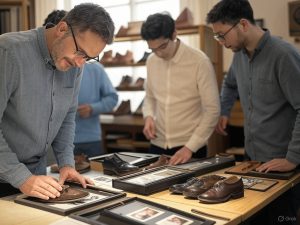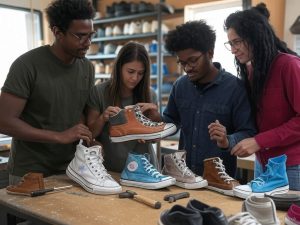
Vintage shoes are more than just stylish throwbacks—they can be surprisingly valuable collectibles. Whether you’re a seasoned thrifter, an online reseller, or someone cleaning out an old attic, knowing how to spot rare, high-value vintage shoes can be a game-changer.
Here’s how to identify which vintage shoes are worth holding onto—or even cashing in.
1. Check the Brand and Label
Start by identifying the manufacturer. Some vintage brands are highly sought after by collectors due to their history, scarcity, or influence on fashion.
Valuable Vintage Brands to Look For:
- Salvatore Ferragamo – Known for early innovation in women’s footwear
- Converse Chuck Taylor All-Stars – Especially pre-1970s editions
- Nike & Adidas – Original models from the 70s and 80s, including early Jordans
- Red Wing & Wolverine – Heritage work boots with a cult following
- Florsheim Imperial – High-quality men’s dress shoes from the mid-1900s
- Dr. Martens (Made in England) – Especially early models with original labels
Pro Tip: Look for the “Made in USA” or “Made in England” tags. These often indicate older, higher-quality production runs.
2. Examine the Construction and Materials
Vintage shoes were often handcrafted with high-quality materials. Look for:
- Goodyear welt construction (common in vintage dress and work shoes)
- Real leather uppers and soles
- Brass tacks, wooden pegs, or hand-stitched details
- Distinctive outsoles (e.g., early waffle soles from Nike)
If the shoes feel heavy and solid, they’re likely better-made—and possibly collectible.
3. Look for Limited Editions or Collaborations
Even in the past, brands released limited-edition models or celebrity collaborations. These are often the most valuable.
Examples include:
- Nike Air Jordan 1 (1985 Original)
- Adidas Superstar “Run-D.M.C.” editions
- Converse collaborations with designers or bands
- Vintage Gucci or Chanel heels from the 60s–80s
Search the model name or serial number (often on the tongue or inner lining) to track down release info.
4. Consider Rarity and Condition
Condition plays a major role in value:
- Shoes in deadstock (never worn) condition are worth the most
- Lightly worn shoes with original boxes also demand higher prices
- Even heavily worn shoes can be valuable if they’re ultra-rare (especially Jordans or designer heels)
Rarity is key. A shoe might not be in perfect condition, but if only a few exist, collectors may still pay a premium.
5. Research Sold Listings and Marketplaces
To determine current market value, check:
- eBay “Sold” listings
- StockX or GOAT (for vintage sneakers)
- Grailed (for designer and streetwear shoes)
- Etsy or The RealReal (for vintage and designer footwear)
Compare your pair’s condition, size, and features to similar sold items.
6. Watch for Fakes
Sadly, the vintage sneaker market is full of counterfeits. Be cautious of:
- Logos that look “off” or misaligned
- Stitches that are uneven or sloppy
- Tags or labels that don’t match known originals
If in doubt, consult a reputable sneaker authenticator or vintage fashion expert.
Final Thoughts
Identifying valuable vintage shoes is part art, part research, and part intuition. Whether you’re preserving a family heirloom or flipping a flea market find, knowing what to look for can help you uncover hidden gems.
Remember: Sometimes, the most valuable thing isn’t the price—it’s the story behind the shoes.


